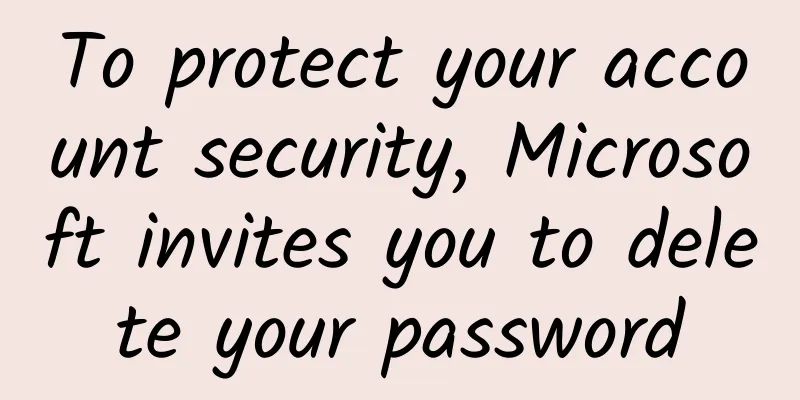To protect your account security, Microsoft invites you to delete your password

|
Now, users can remove passwords from their Microsoft accounts and choose alternative authentication methods. Microsoft says passwords are no longer safeMicrosoft said that the simple password mechanism has become the weak point of the security system, with up to 18 billion attacks on passwords each year, about 579 times per second, among which weak passwords are the entry point for most attacks on cross-enterprise and consumer accounts. In the words of Microsoft Chief Information Security Officer Bret Arsenault, "Hackers don't break in, they log in." According to the survey, 15% of people use their pet's name as a password, similar to surnames, birthdays, etc. 10% of people said they use the same password for different accounts. 40% of people use some common passwords, such as love520 and Spring2022. In addition, nearly one-third of people said that they had completely stopped using an account or service because they forgot the password. Passwords are no longer safe, Microsoft urges users to delete them. The best way to protect your password is to delete itWhen users delete their passwords, Microsoft provides three alternative authentication methods: Windows Hello for Business, Microsoft Authenticator app, and FIDO2 (Fast Identity Online) security key. Among them, Windows Hello is a biometric authentication method built into Microsoft devices. The FIDO2 security key is a piece of hardware similar to an online banking electronic key that is inserted into a computer for use. The easiest way for ordinary users to use it is the Microsoft Authenticator application. Microsoft said that the Authenticator application can turn any iOS or Android phone into a strong, password-free credential. The use of Authenticator is also very simple. Users first install the APP on their mobile phones. When logging in to an account on other platforms, the login interface will prompt a verification code. Users complete the verification code matching in Authenticator and use the phone's Face ID or fingerprint recognition to confirm the login. After experiencing it, I found that the whole process of entering passwords was simplified to one click and facial recognition. Since the user has deleted the password, there is no longer any password leakage in the process. In addition, through the rapid cloud response, the mobile phone can be used to log in to the account on any platform to use personal biometric information for identity authentication, which prevents the account from being stolen. In Microsoft's words, "significantly or permanently reduce account risks." Cloud technology services penetrate into the C-endAs our daily lives merge online, the identifier for identifying individuals online in the future will definitely not be a password, but the individual himself. Based on the cloud service Azure, Microsoft provides a cross-end personal identity solution that allows users to log in securely on devices that do not have fingerprint recognition, face recognition, or iris recognition. Microsoft's password-free login was first launched among commercial users and has now been expanded to all consumer users. This may be one of the trends of the cloud market penetrating into the C-end. We have observed that when many consumer Internet companies are shifting from C-end services to B-end services, the cloud market, which started on the B-end, is exporting technology to the C-end. In the future, when these technologies form a scale effect on the C-end, they will definitely feed back to the B-end. It is understood that Microsoft Azure AD multi-factor authentication system launched a public preview in 2019. According to data released by Microsoft in November 2019, more than 100 million people use password-free login every month. Alex Simons, the vice president who manages the project, called 2020 a breakthrough year for password-free technology. This year, the number of people who used biometric recognition technology to log in to work accounts was close to 300 million. (Note that these data are different from the number of people who have completely deleted their passwords) A password-free Internet is an Internet centered around the "cloud". Behind Microsoft's advocacy of "password-free", it is aiming at a potential blue ocean of value. However, for ordinary consumers, the mobile phone in their hands has undoubtedly become more important. Whether it is AR/VR devices, wearable devices, or any smart hardware, all instructions will be collected and distributed on this screen. |
<<: How to detect whether WeChat has been blocked or deleted? Three methods, easy to do
Recommend
The Shenzhou 14 crew took photos in orbit
This year's National Day was the first time t...
2016 Network Wish List: Less Hype + More Automation
[[161361]] Wishes don't always come true, but...
How far are we from domestic brands launching OLED TVs?
About ten years ago, LCD TVs sounded the clarion ...
Application of Image Technology in Live Broadcasting (Part 1) - Beauty Technology
2016 is the first year of video live streaming. W...
If the Earth doesn't end in a helium flash, what will end in it?
The science fiction novel "The Wandering Ear...
Is it easy for Douyin stores to get orders? Is it easy for Douyin stores to get orders?
Many merchants who have opened Douyin stores are ...
Promotion methods of APP new media marketing!
The basic tone of the APP operation and promotion...
The Jade Rabbit stretches out its fists and paws, and the herbs herald the arrival of spring: a list of plants named after the word "rabbit"
The New Year's bell has rung, and the four se...
Don’t get lost when seeing a doctor | What the hell, how to see a doctor for respiratory diseases
...
When will the Anhui epidemic end in 2022? When will the ban be lifted? Attached the latest news
Recently, many provinces and cities including Huna...
The gas tank explosion at a barbecue restaurant in Yinchuan has killed 31 people! If a gas tank catches fire or explodes, how can you save yourself?
On the evening of June 21, a gas explosion occurr...
Unraveling the Google DevOps puzzle: What qualities make for a world-class, reliable system?
Randy Shoup, who helped lead engineering teams at...
Dog Brother Notes's Mutual Aid Course "Short Video System Thinking + Practical System Course" Collection
Introduction to training course content: This trai...
Google announces the official version of TensorFlow: Open Source Machine Learning
On February 16, Google suddenly posted an announc...
Is this plant called "Wintersweet" or "Wintersweet"?
As the Cold Dew solar term passes, the weather be...









